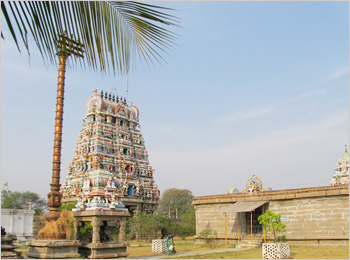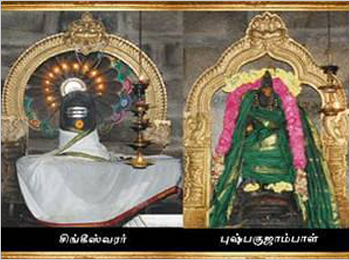The Graceful Singesswar Temple is located in Mappedu on the Thakkolam route near Chennai, India. This sacred temple vibrates with the energy of Moola nakshatra and has great significance for those born under this star. The sounds of the Tamil alphabet are closely associated with the Mappedu Temple. Lord Shiva manifested as Sri Singesswara and gave the sacred gift of the Tamil alphabet ‘nga’ to the great Saint Agasthiya. At Mappedu Temple Agasthiya shared this knowledge with a sage named Sudha budha Munivar, who introduced the alphabet to the world.
Through these holy sounds, the shrine at Mappedu Temple holds sacred energy for music. Moola star day is the most auspicious day for Sri Singeeswarar, who is the lord of music. On this day, he generated the sound of ‘aum’ as a lion’s roar. At this temple, a devotee named Sri Anjaneyar piously worshipped Sri Singeeswarar. Then, on Moola nakshatra day, Anjaneyar was blessed as Goddess Saraswati wrote the musical note of ‘aum’ onto his tongue with a white lotus flower. Anjaneyar shared this note as he played a special wind instrument at Mappedu Temple.

The Singeeswarar temple was built by Aditya Karikalan II in the year 976 AD. He is the father of Rajaraja Cholan who built the Thanjavur Big Temple. The Rajagopuram-Main Tower, compound wall and 16 pillar Mandap built in the year 1501 during Krishnadevaraya period. The sthala vriksham is Elandhai Tree.
During Aarudhra darisanam (in the Tamil month of Margazhi) the fruit of Elanthai tree is included in the preparation of Pancha-amirtham during abhishegam to Natarajar.

Lord Shiva as Sri Singeeswarar graces the temple along with Goddess Pushpagujambal. This is a recently renovated ancient temple and is a special temple for people born in ‘moolam’ star.
There is a vigraha of Sri Hanuman in front of Lord Singesswarar shrine playing the Veena, an ancient divine musical instrument of India. People, who seek skill in music, pray to him. There is an idol of Sri Anjaneya playing the Veena. Those aspiring skill in music pray to him in particular. Birth star of Anjaneyar is Moolam.
It is notable that the birth star of Kalaivani-Saraswathi, the Goddess of Wisdom is also Moola. It is said that Mother Saraswathi wrote the Singanatha seed letters (Beejakshara – Beeja means seed, Akshara-letters) on the tongue of Sri Anjaneya with the stem of a lotus flower.
This is believed to have given Lord Hanuman clarity in his speech and an aptitude to protect people in distress using tactics needed for the time. He is celebrated as Sollin Selvan in Tamil and Nava Vyakarna Pandit in Sanskrit. Moola people are advised to pray in this temple for gaining excellence in education and speech.
There is a shrine for Sri Veerabaleeswara in the northeastern corner of the temple the dating back to 5000 years. It is believed that whoever worships the presiding deity and Nandhi (vehicle of Lord Shiva) simultaneously at Pradosham hours (4.30 p.m. to 6.00 p.m. each day) standing on the Nava Vyakarna stone, will be cured of all bone and joint related diseases.
It is also believed that people would realize their wishes if they pray to Mother Durga for 42 weeks continuously by lighting lamp in the shrine. Sri Nandi Deva, the vehicle of Lord Shiva, also called Singhi, played the Mridangam, to the moves of the Lord at Tiruvalangadu, one of the five Sabhas identified with Shiva's Dance.
Sri Nandi was totally immersed while playing the mirudangam, shutting his eyes, thus could not witness the dance. Hence he prayed to Lord Shiva to dance for him again.
Satisfied with his sincere devotion, Lord Singesswarar asked Nandi to come to Meipedu, where he got a chance to witness the cosmic dance of Shiva.
As Singhi-Nandhi revered in the spot, the spot is named as Singheeswaram and the Lord Singheeswarar. Goddess is revered for the sake of Pushpagujambal-Poomulainayaki identified with fragrant blooms. Mother Pushpagujambal is found in a separate shrine facing east. The mandapa of the ambal shrine has good sculptures.